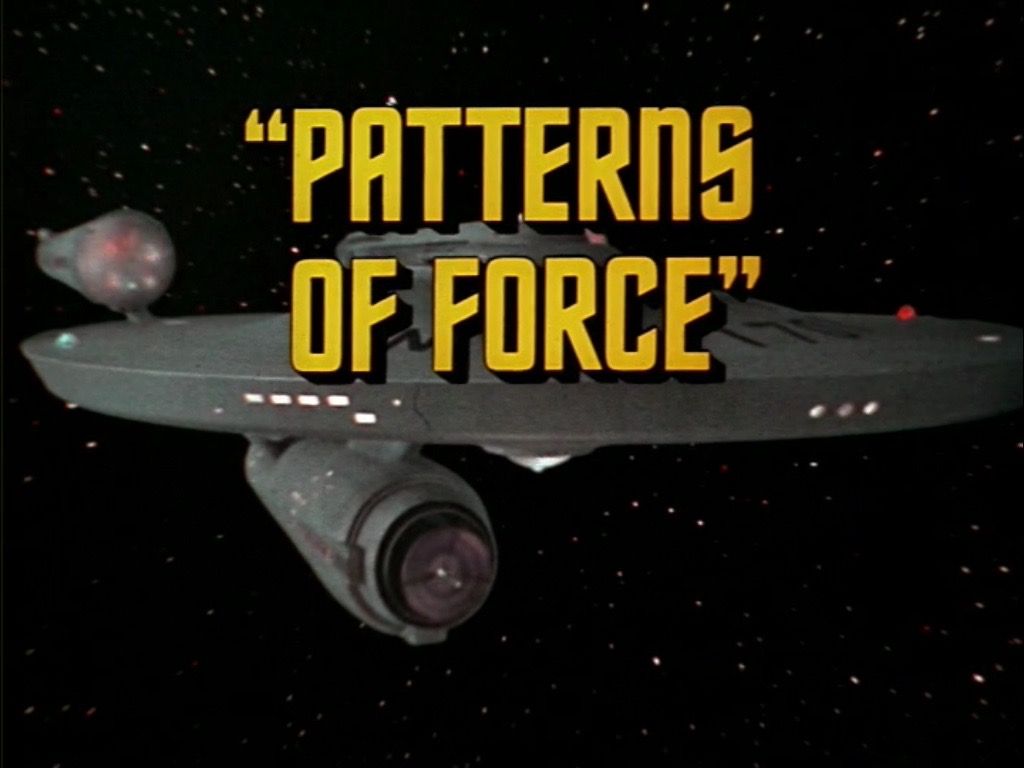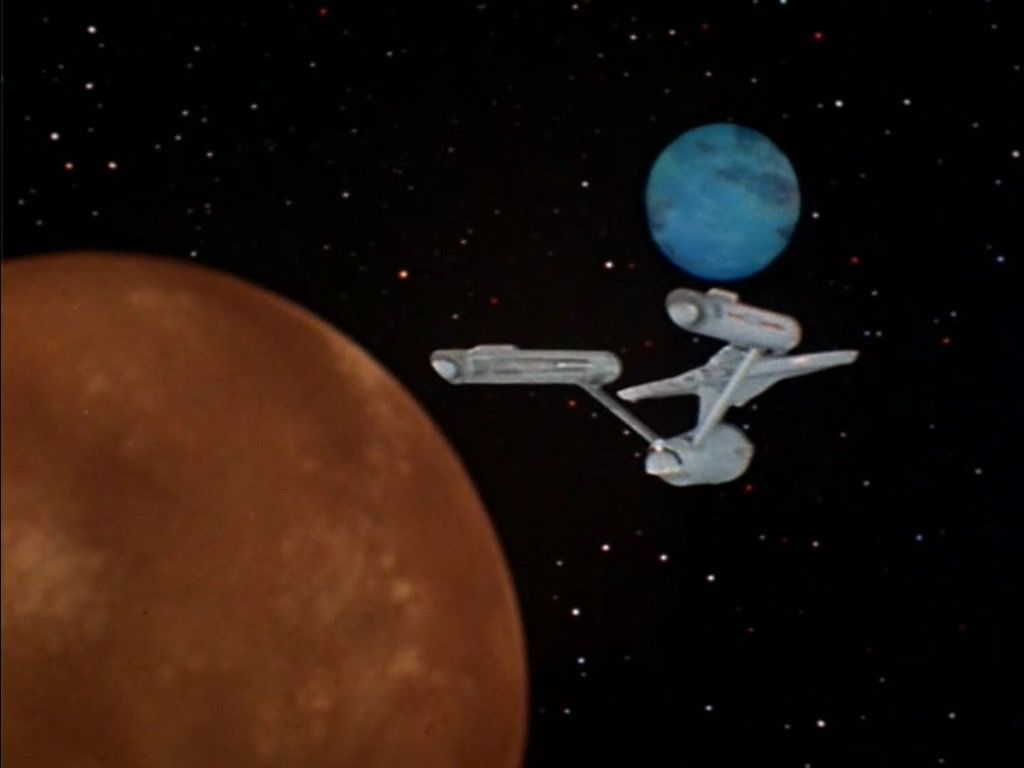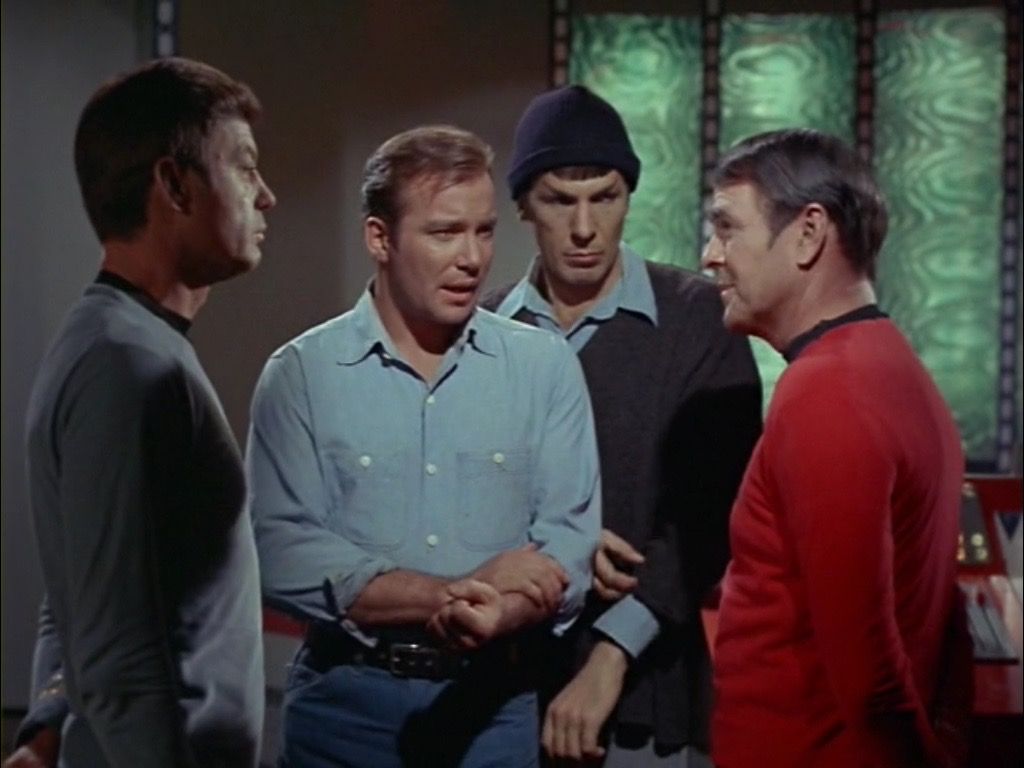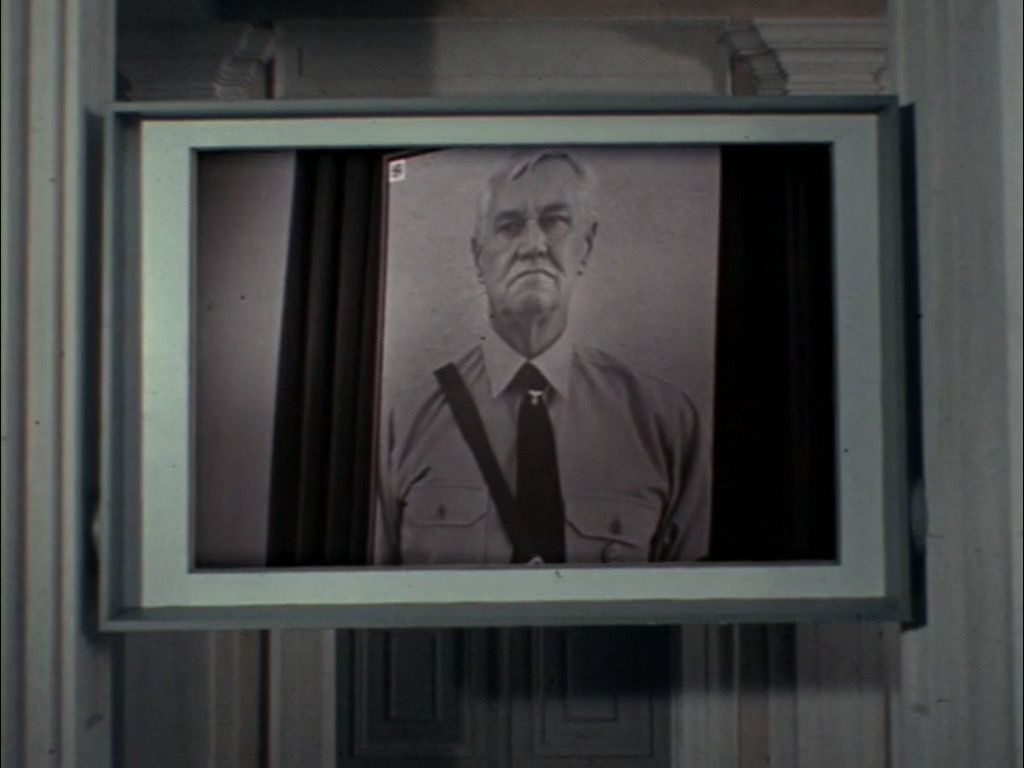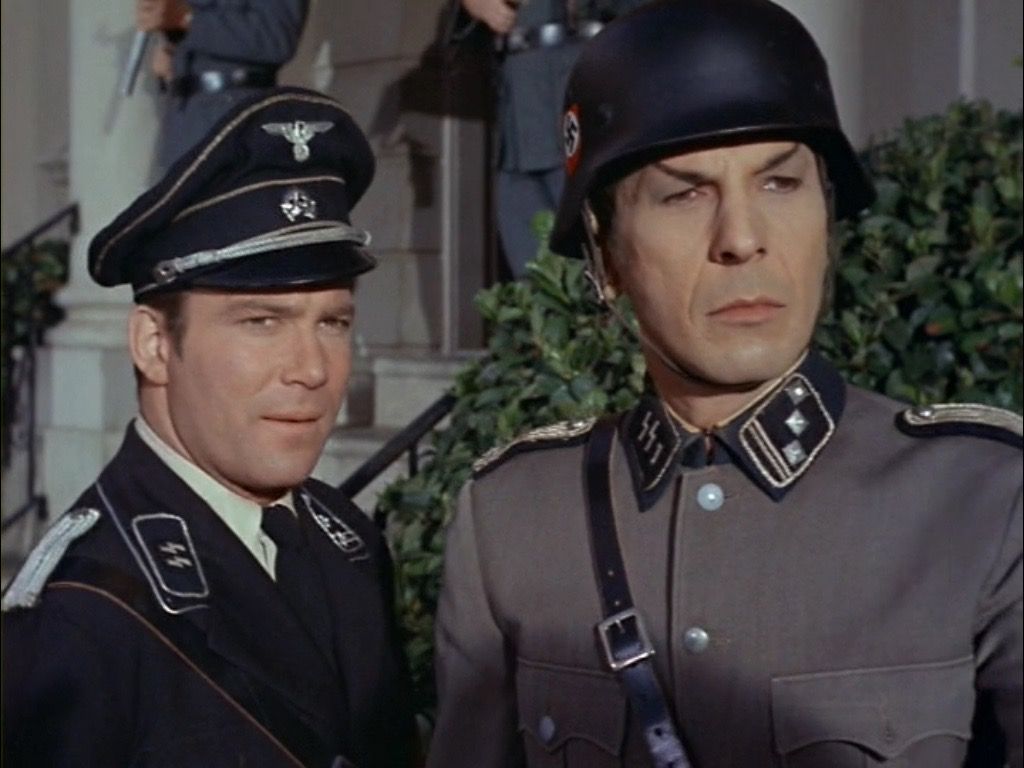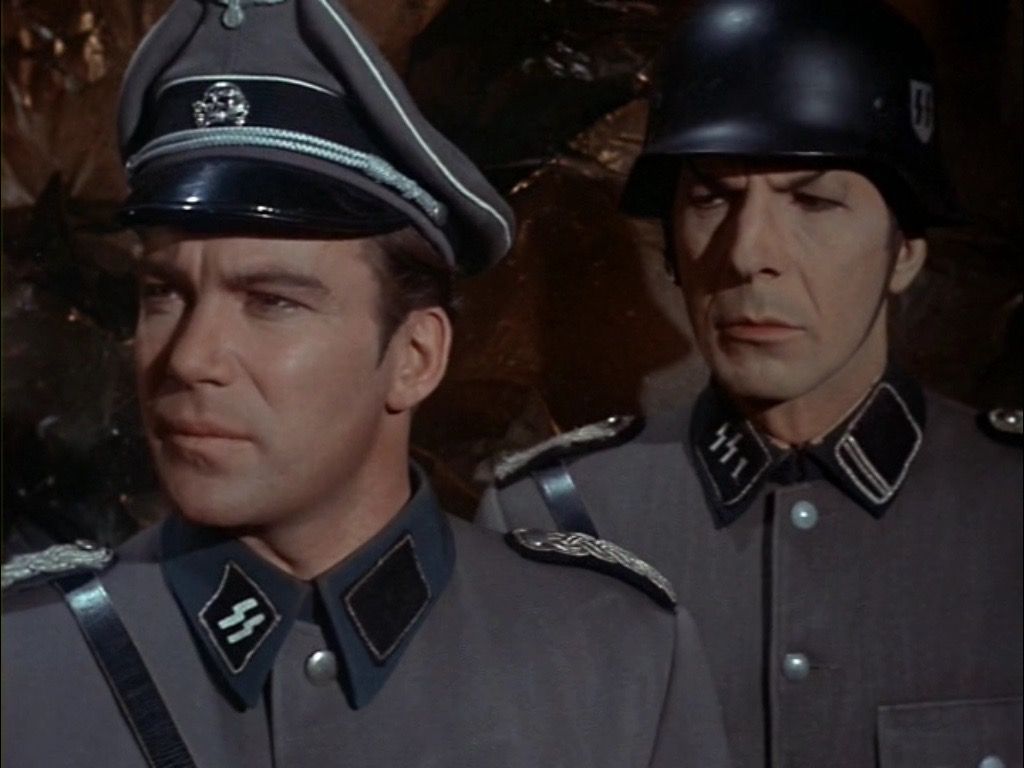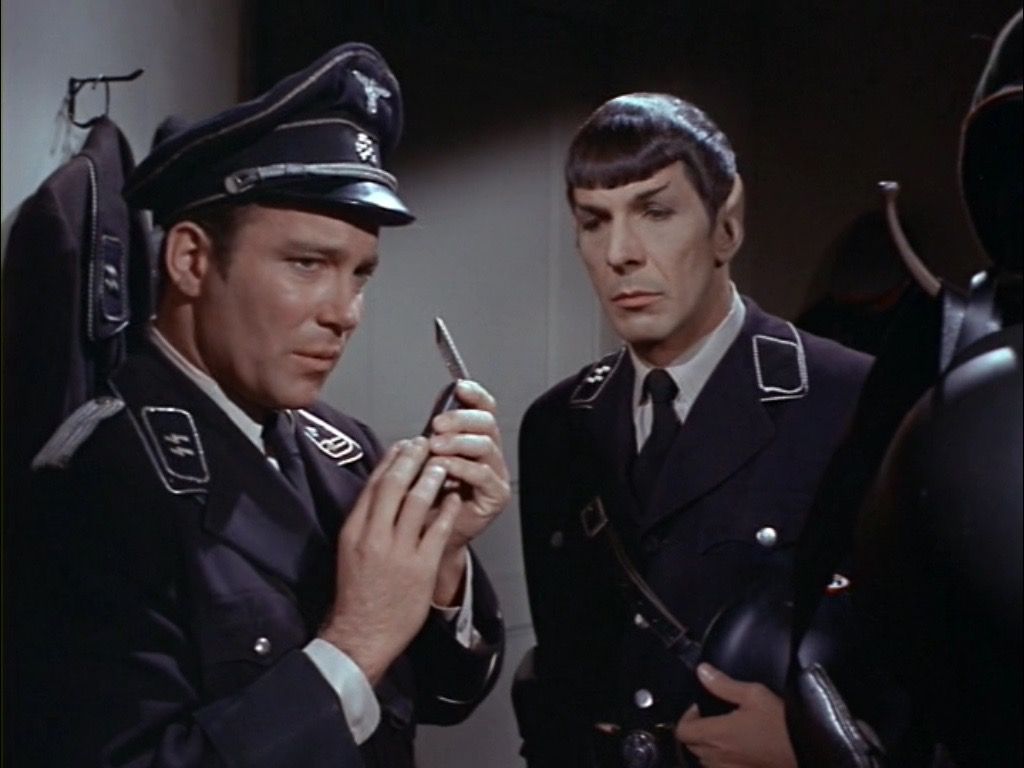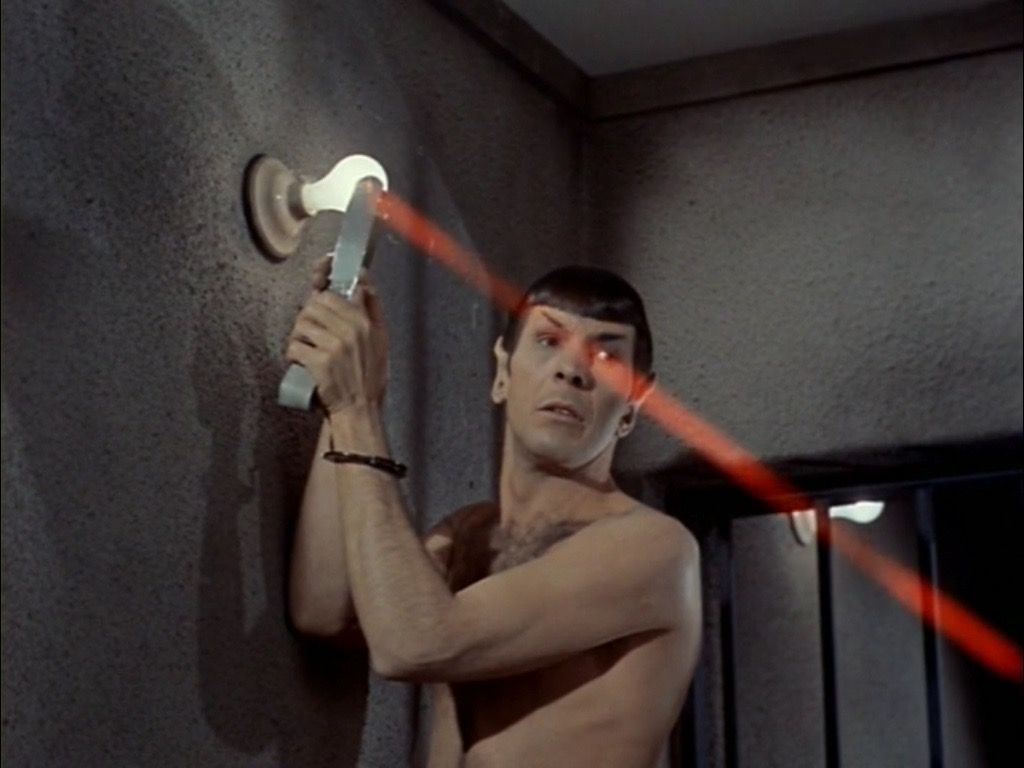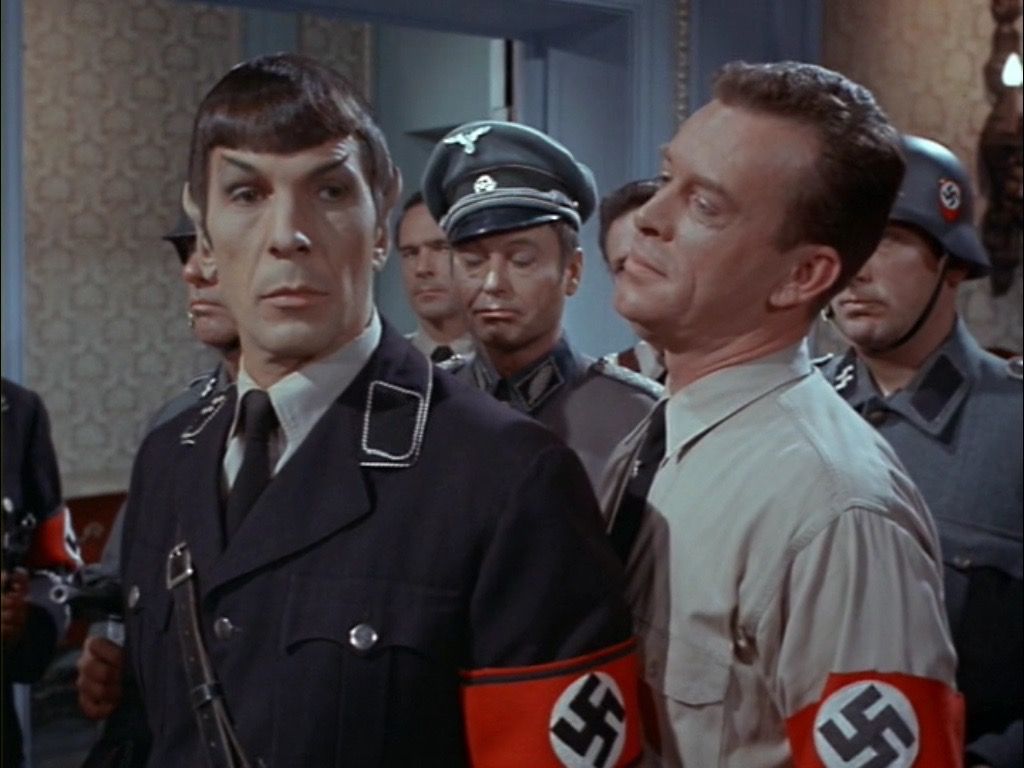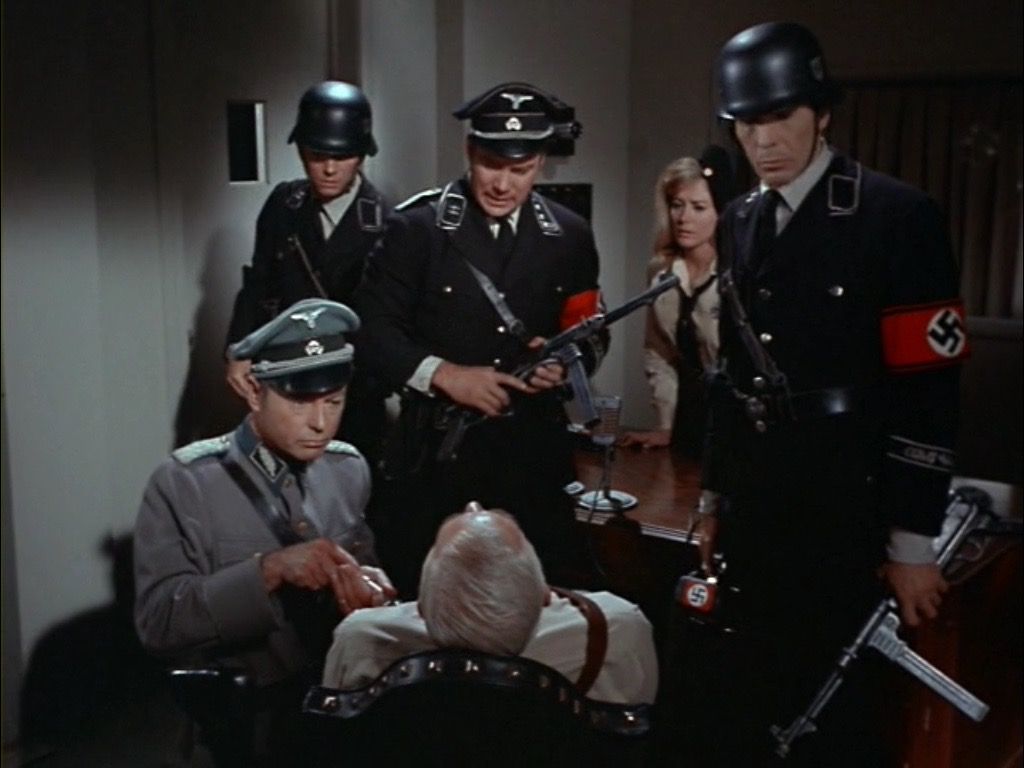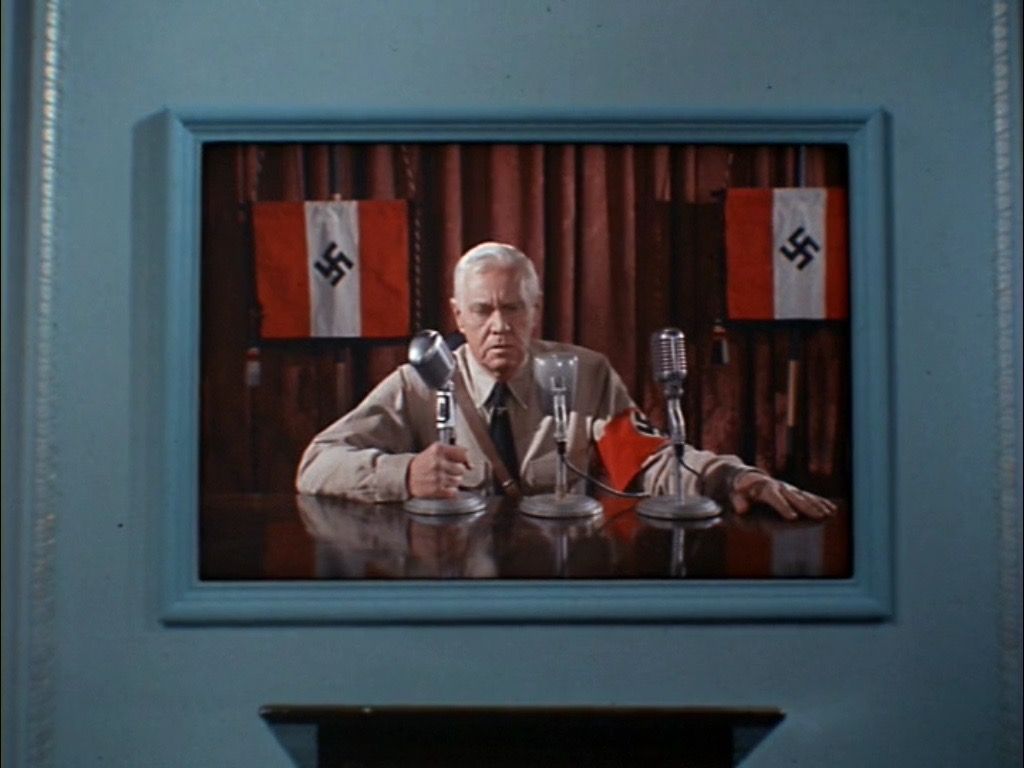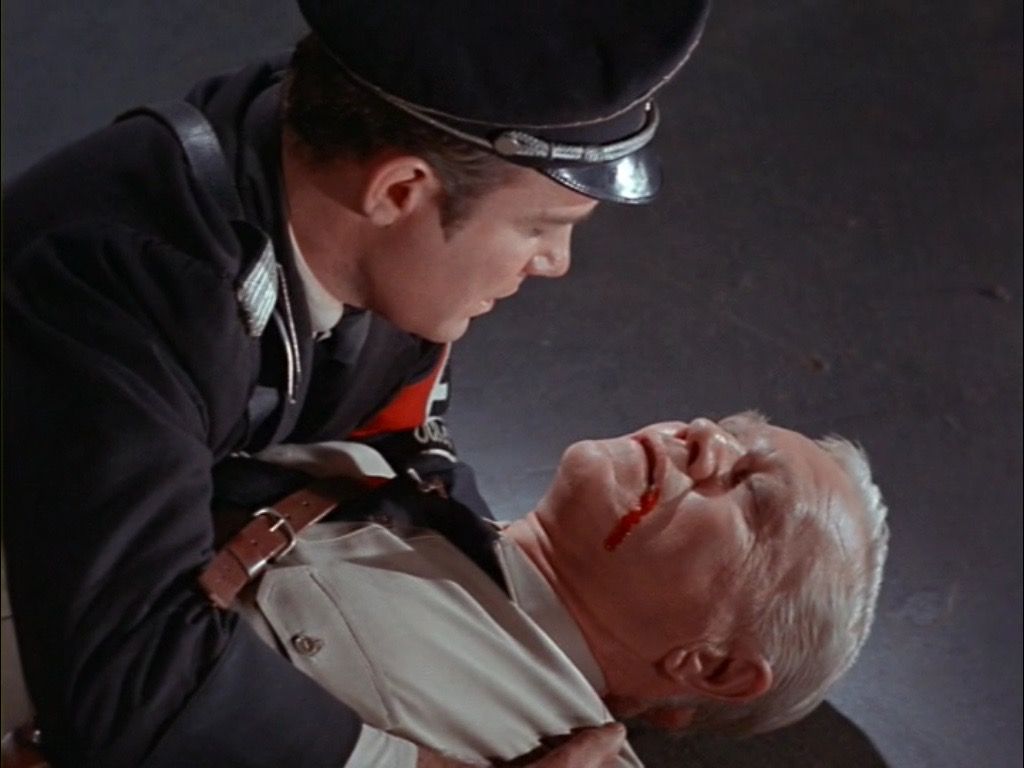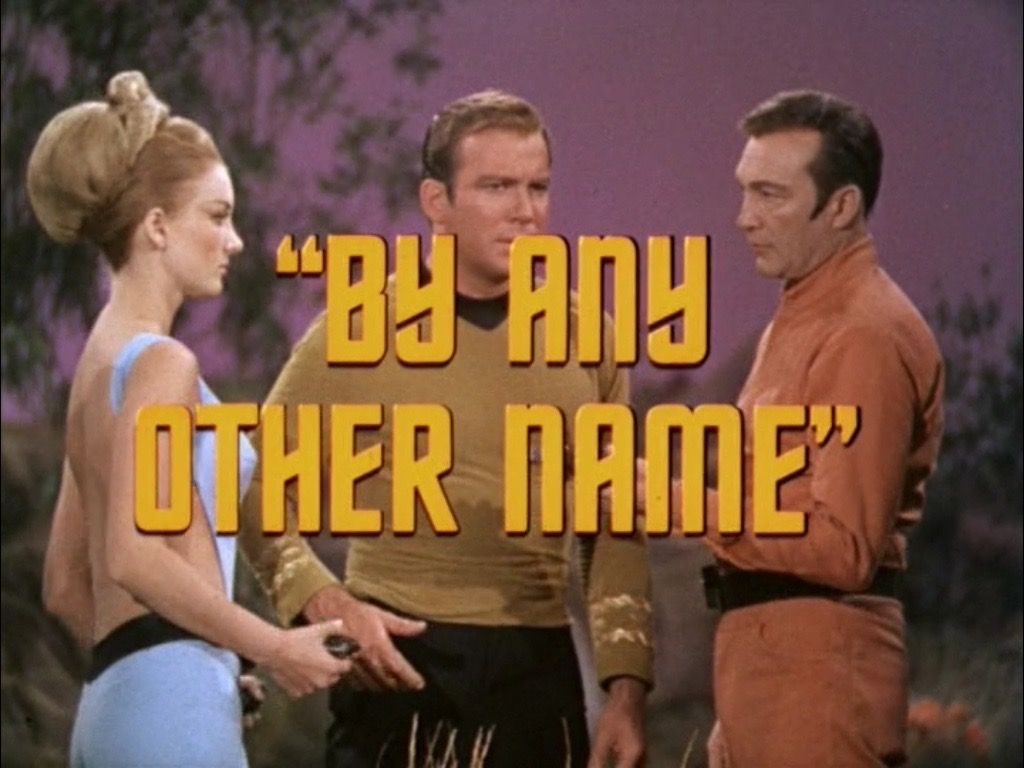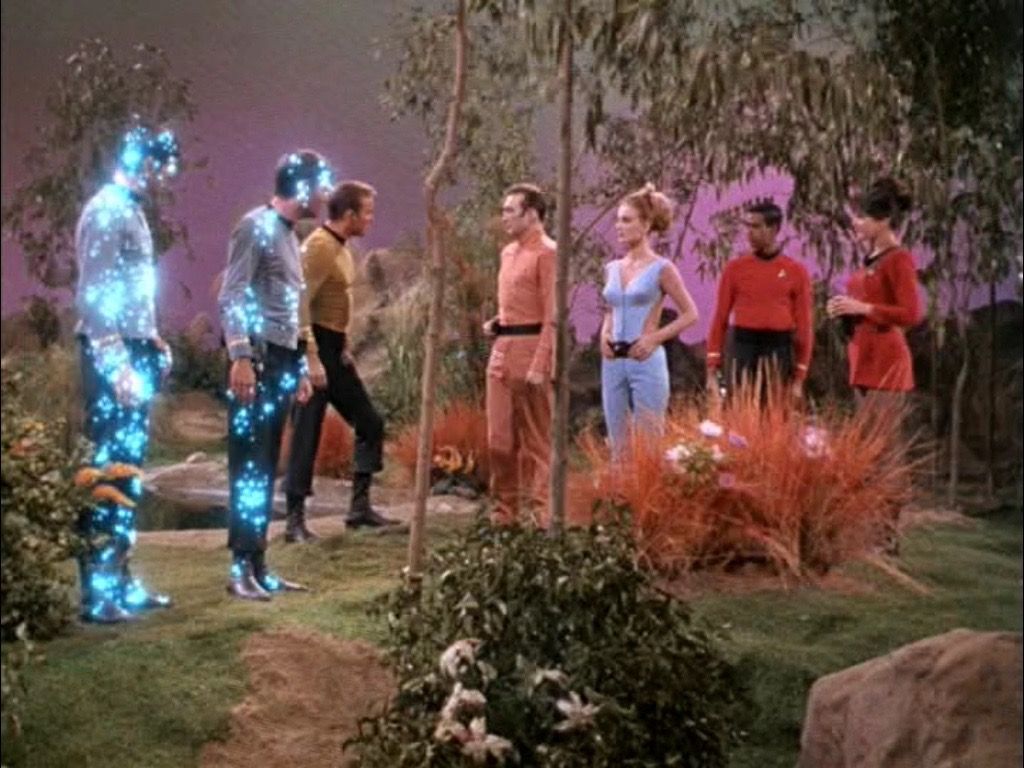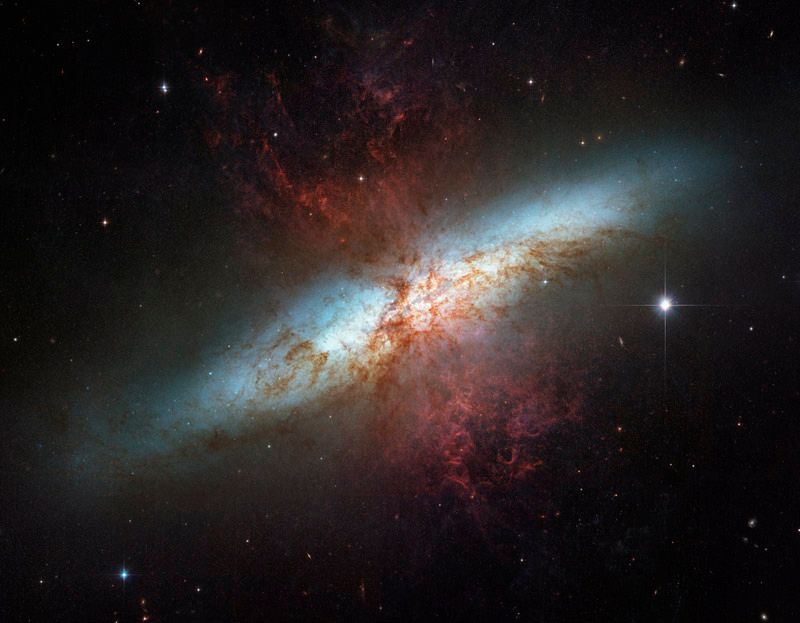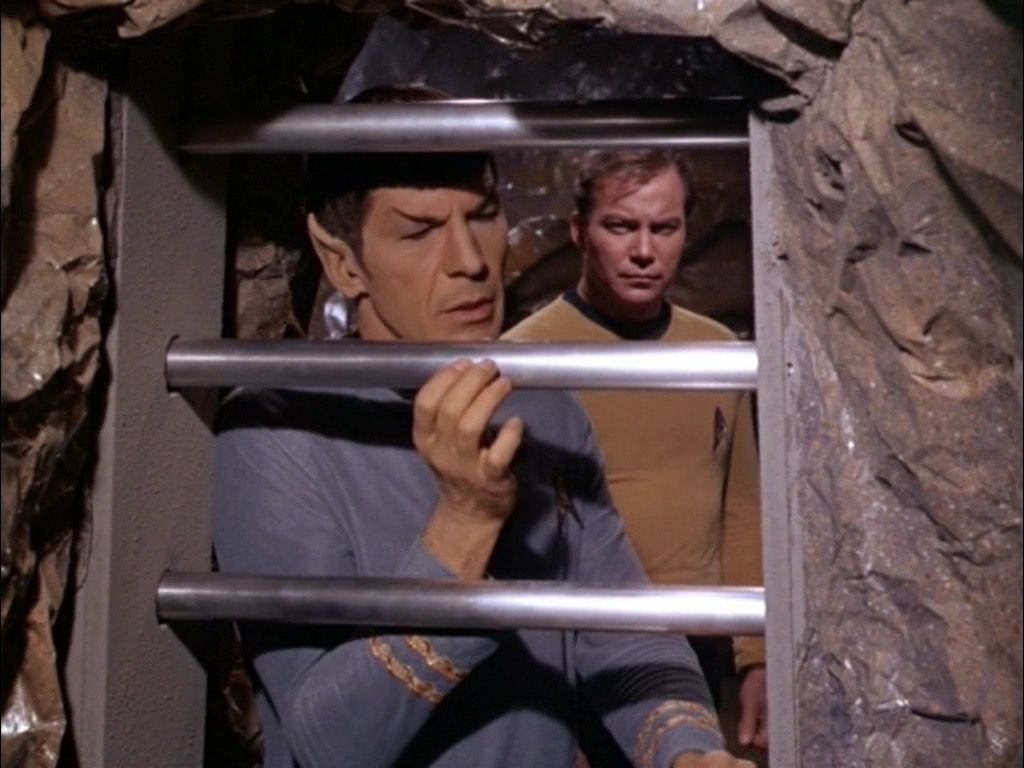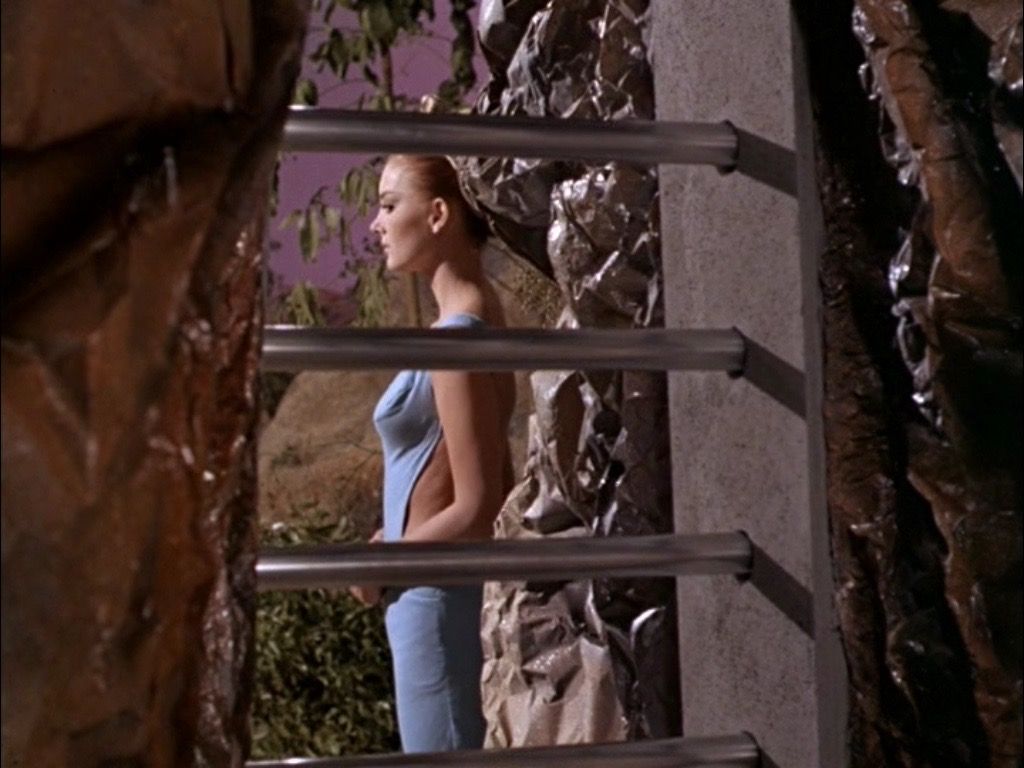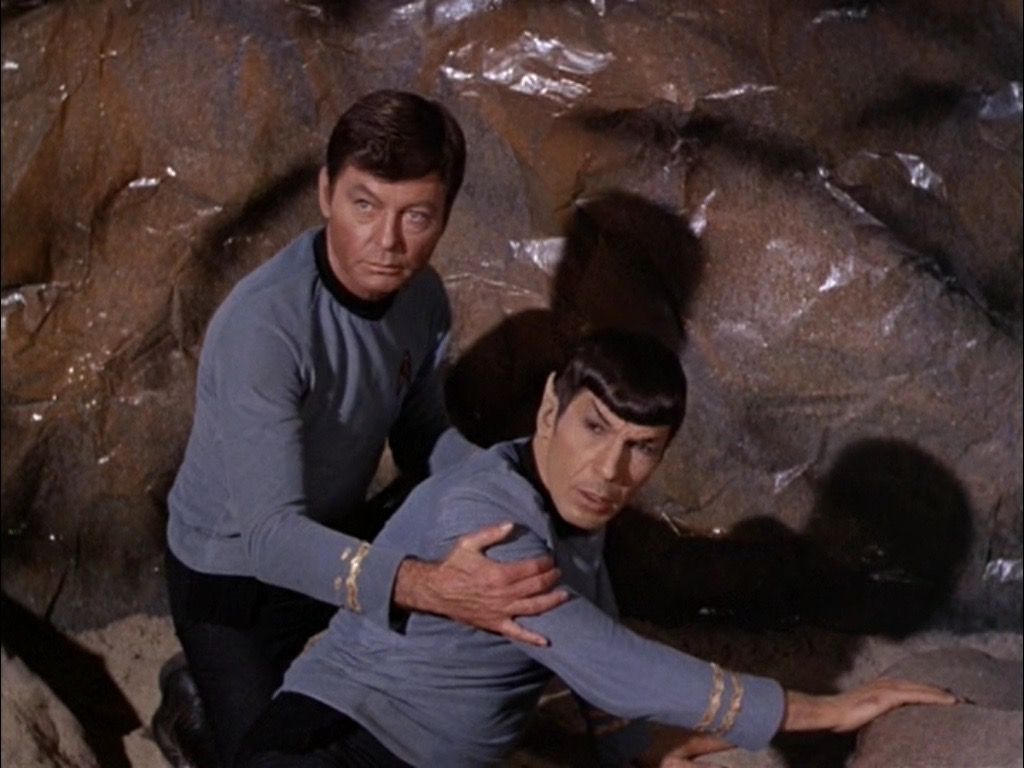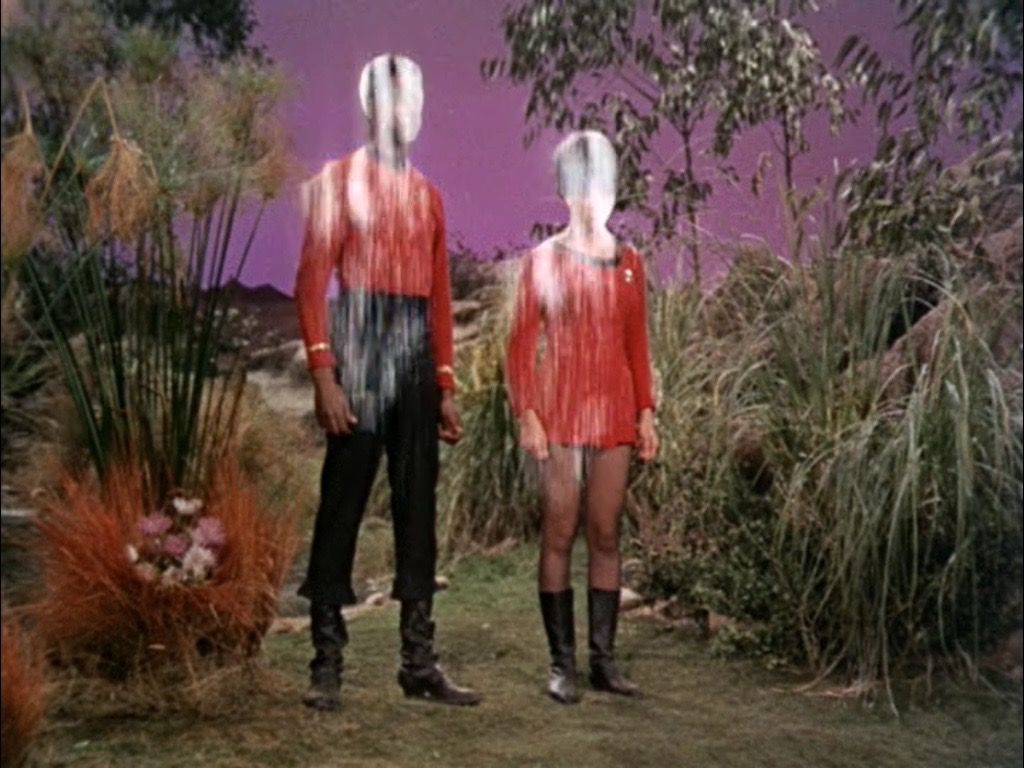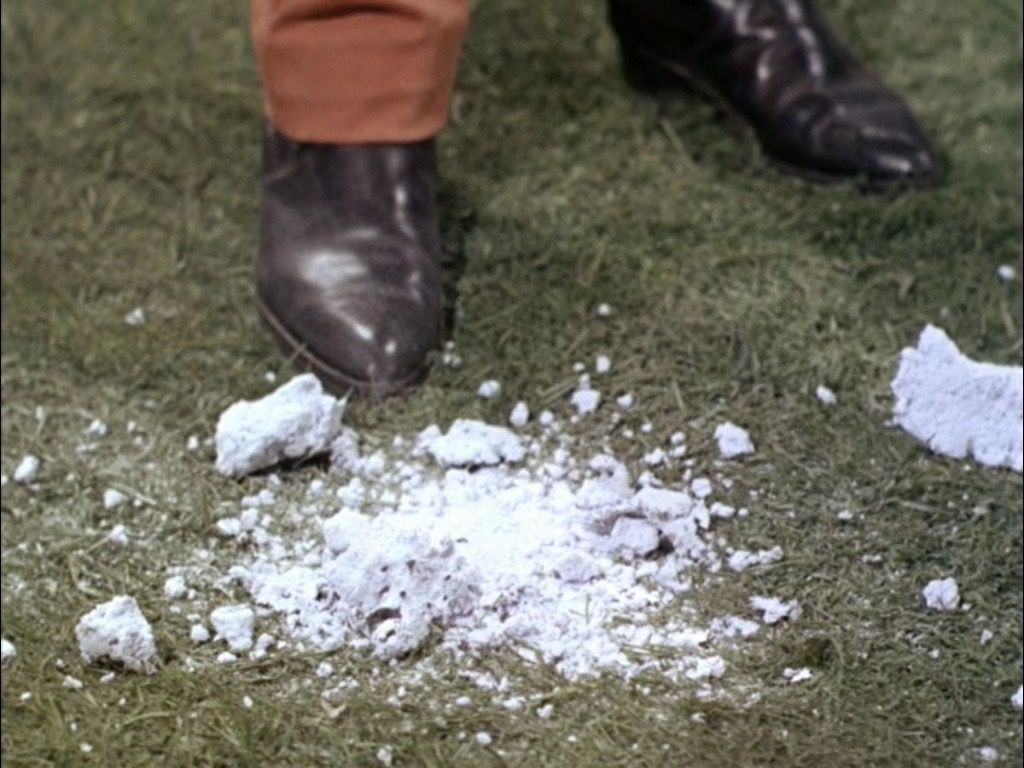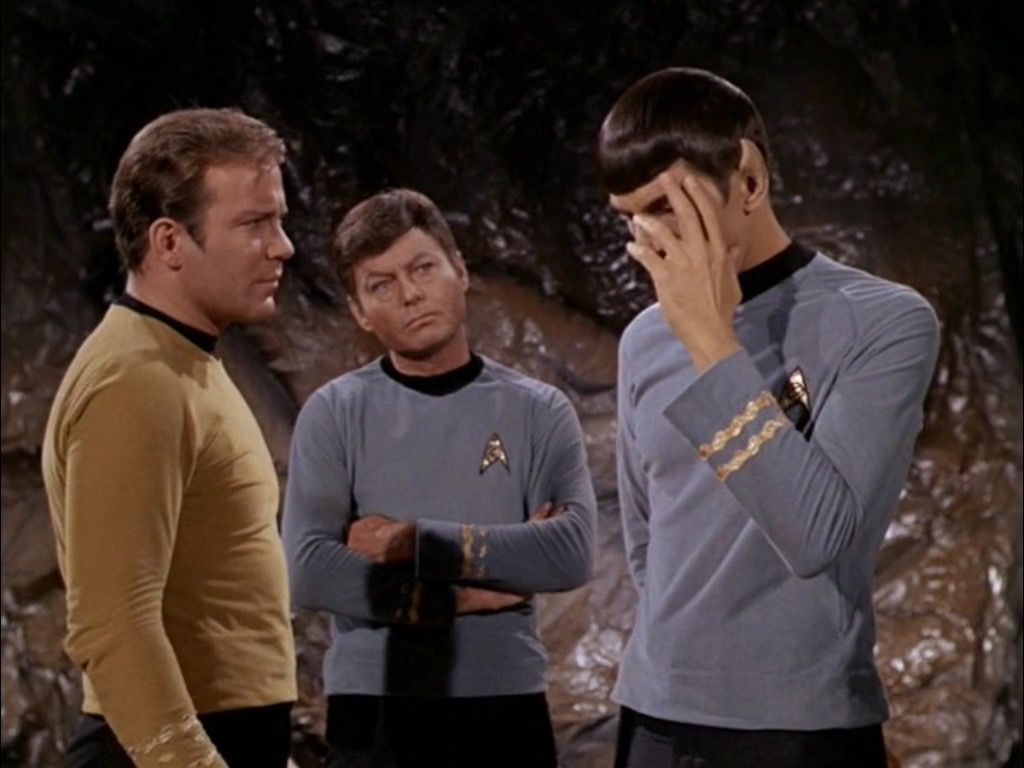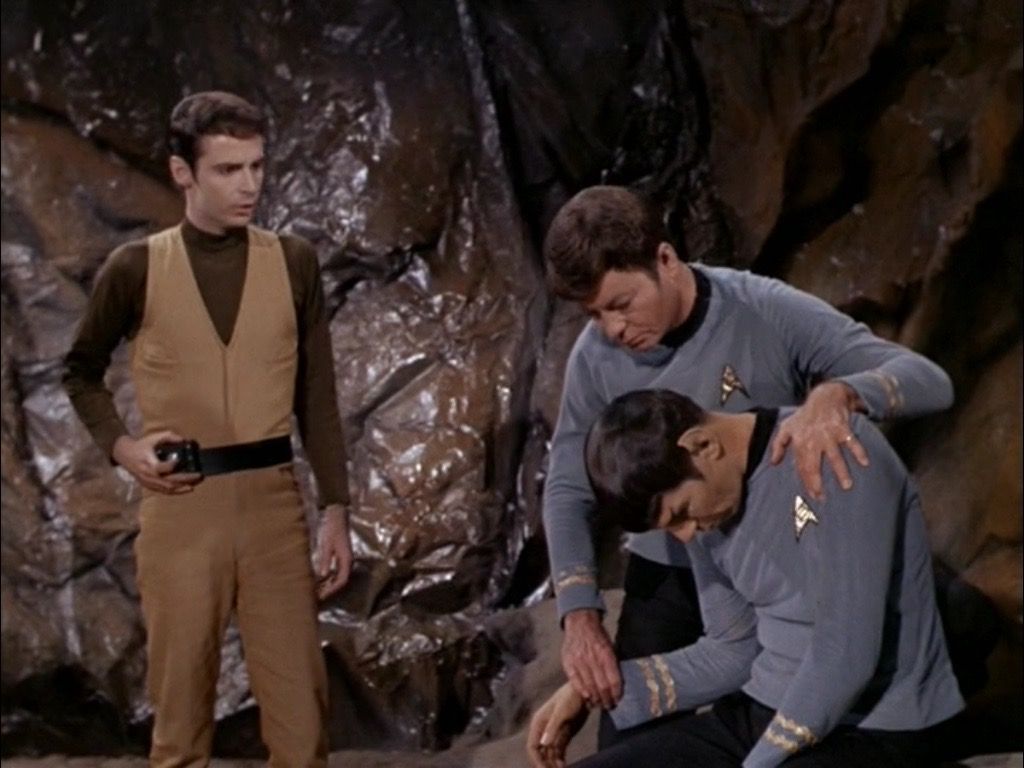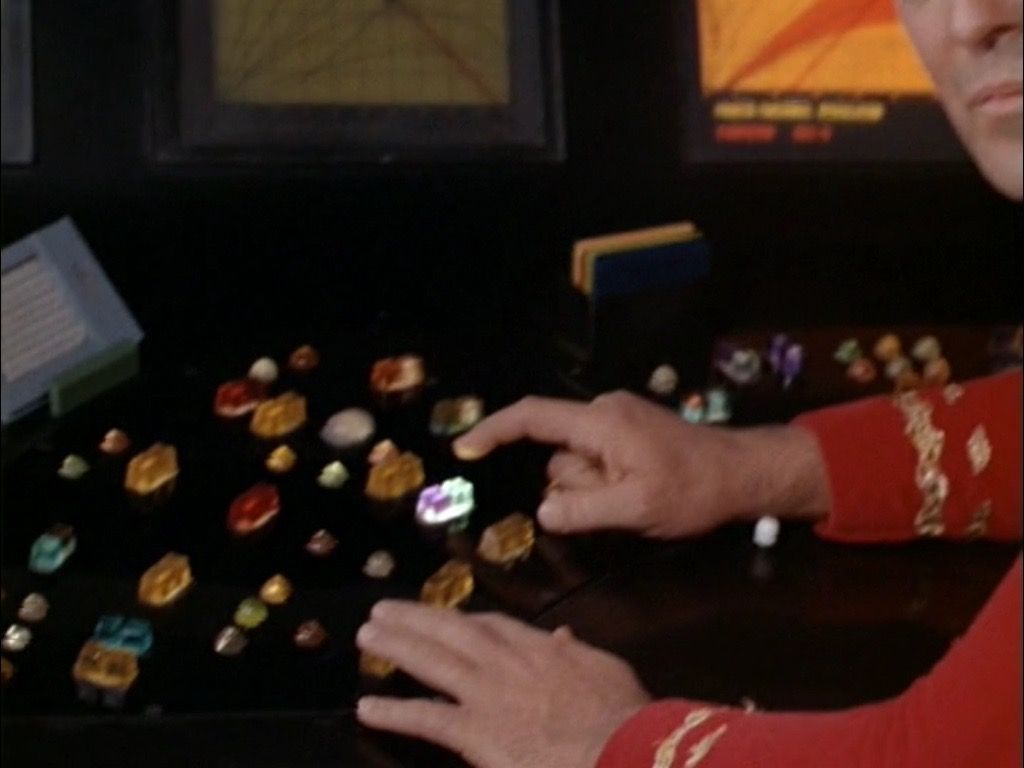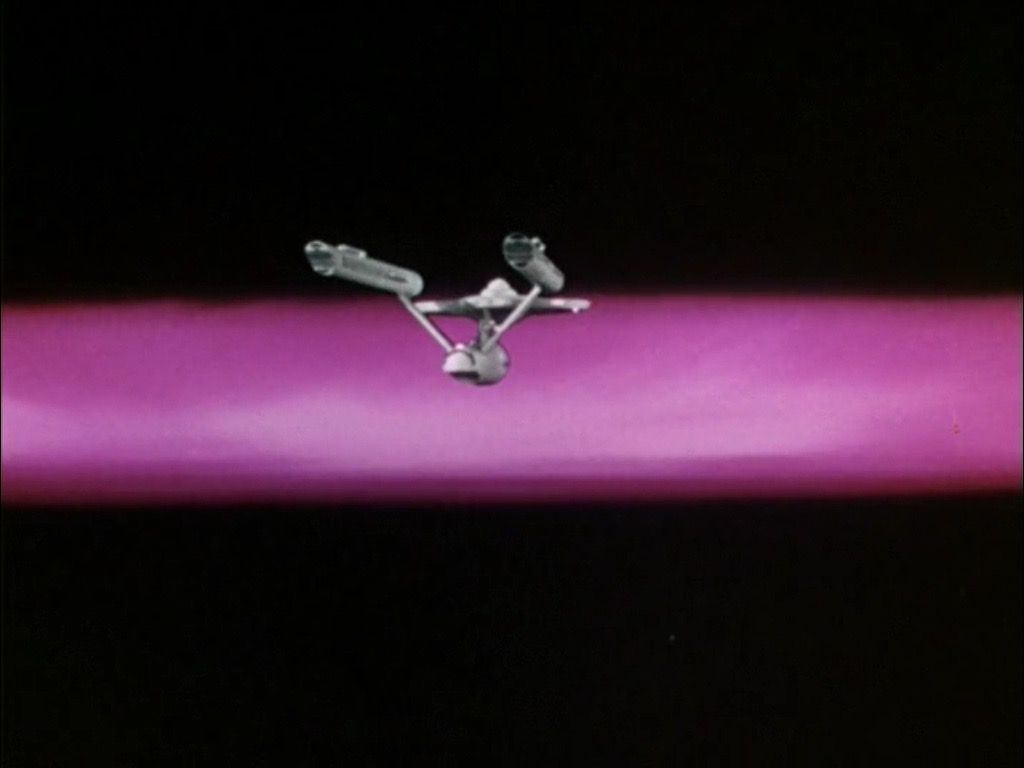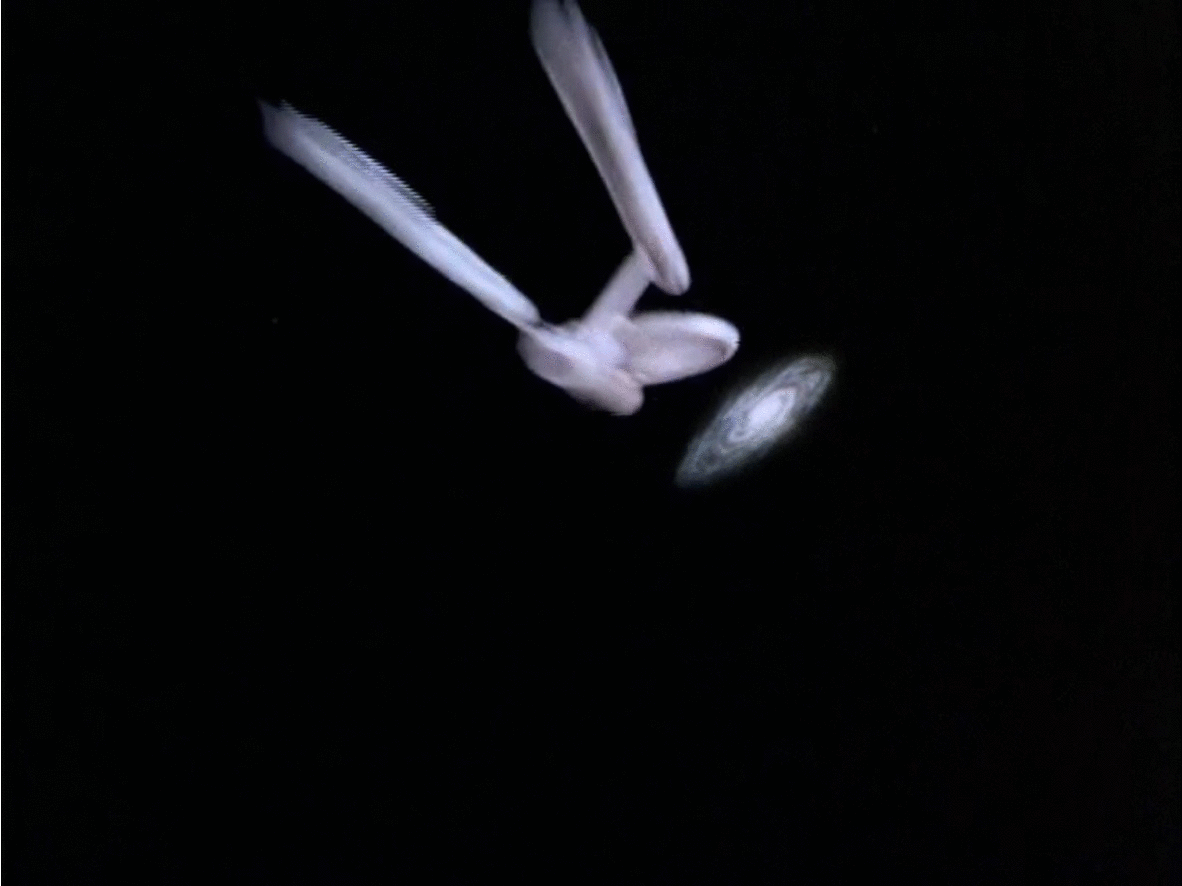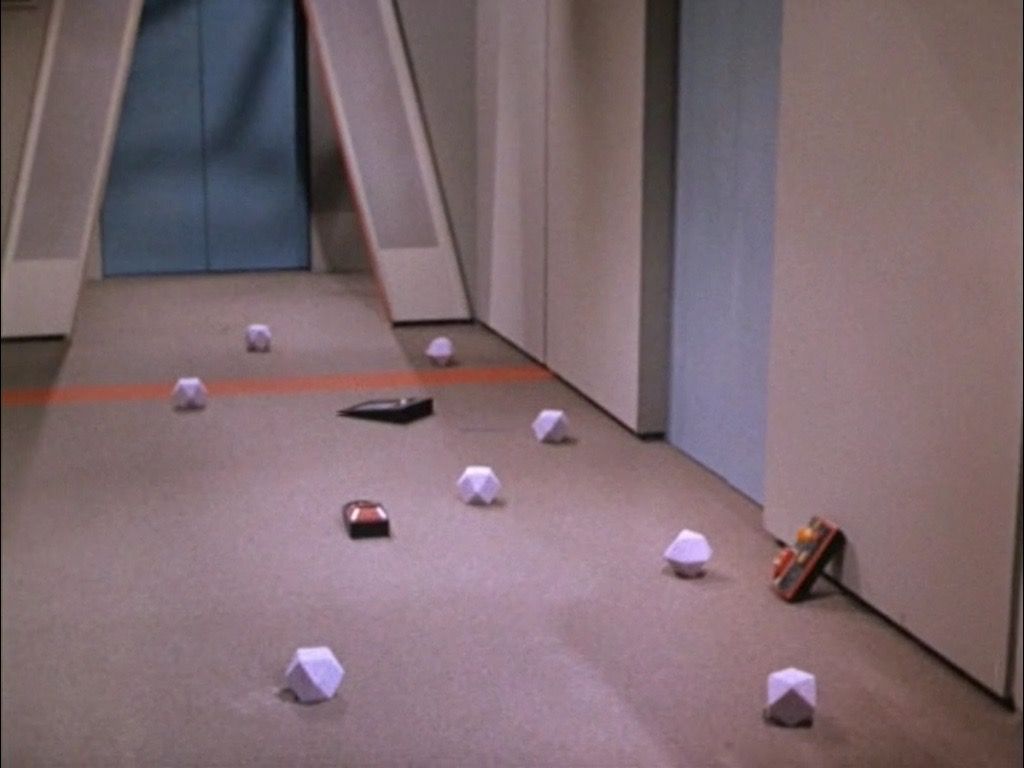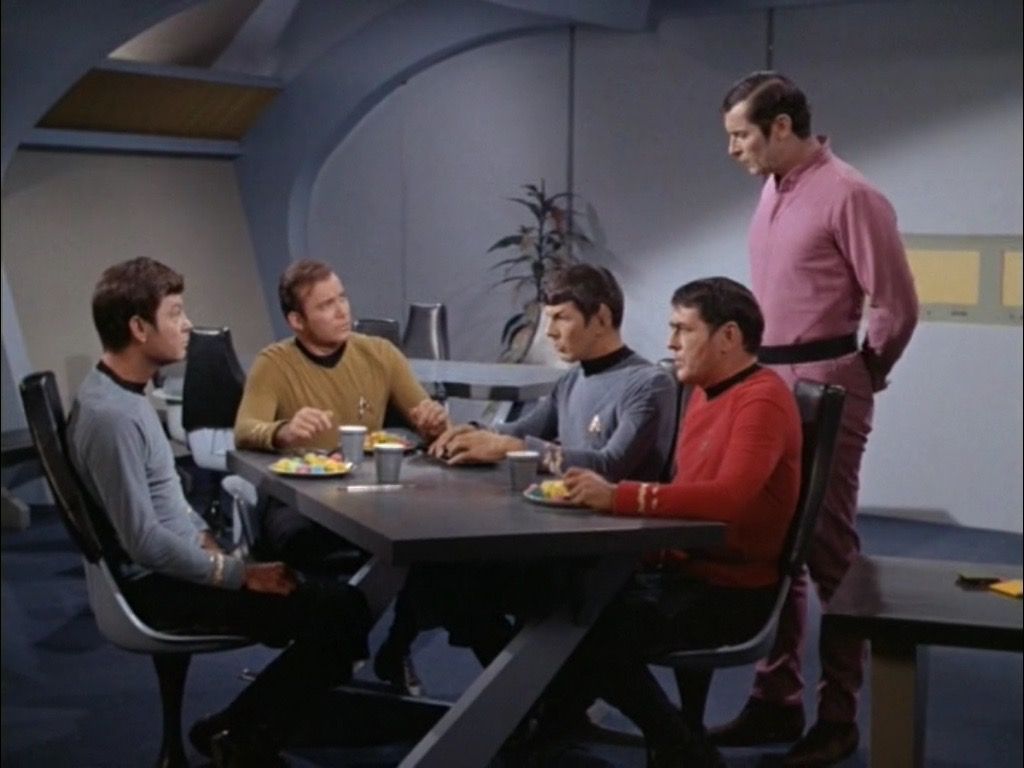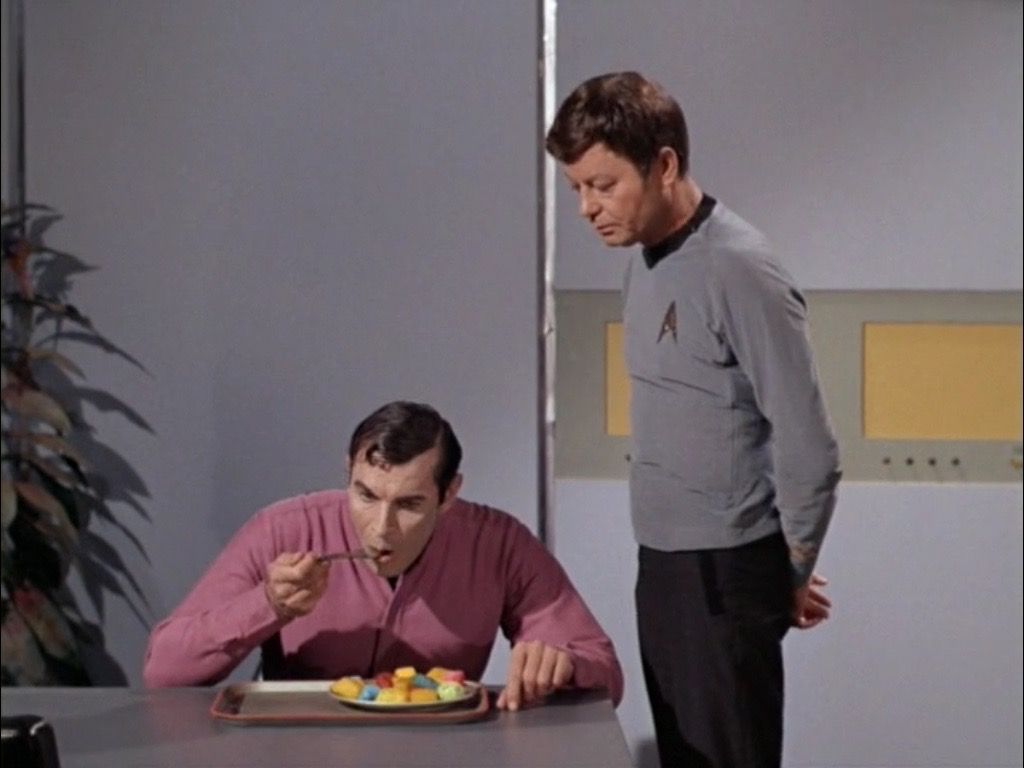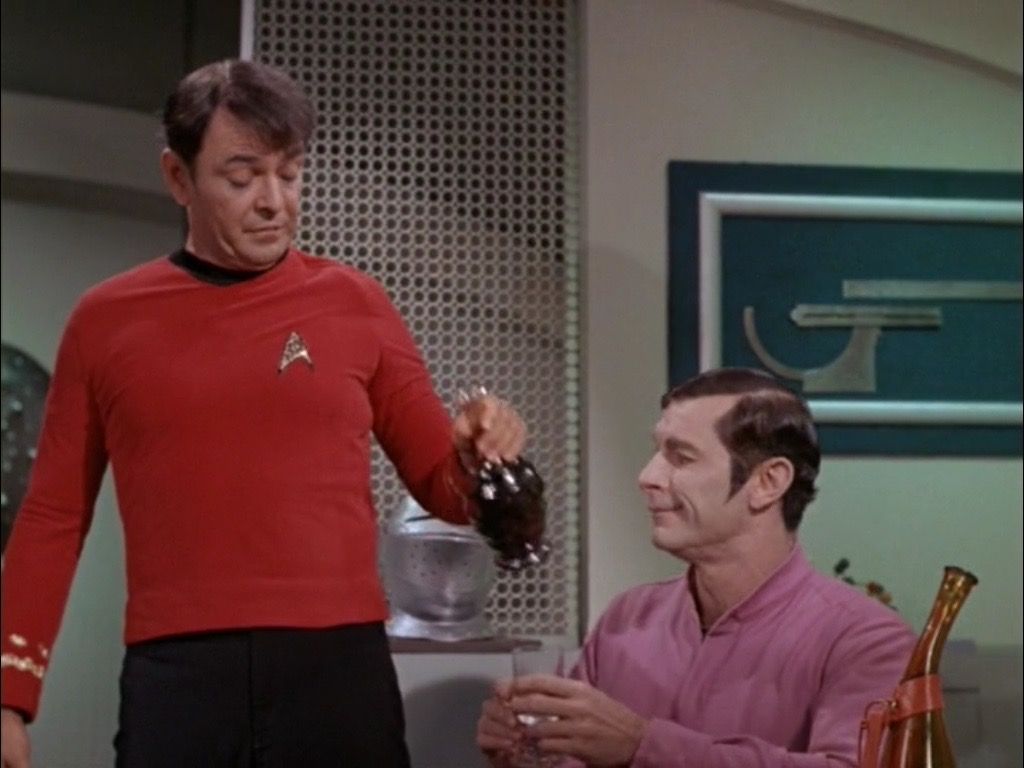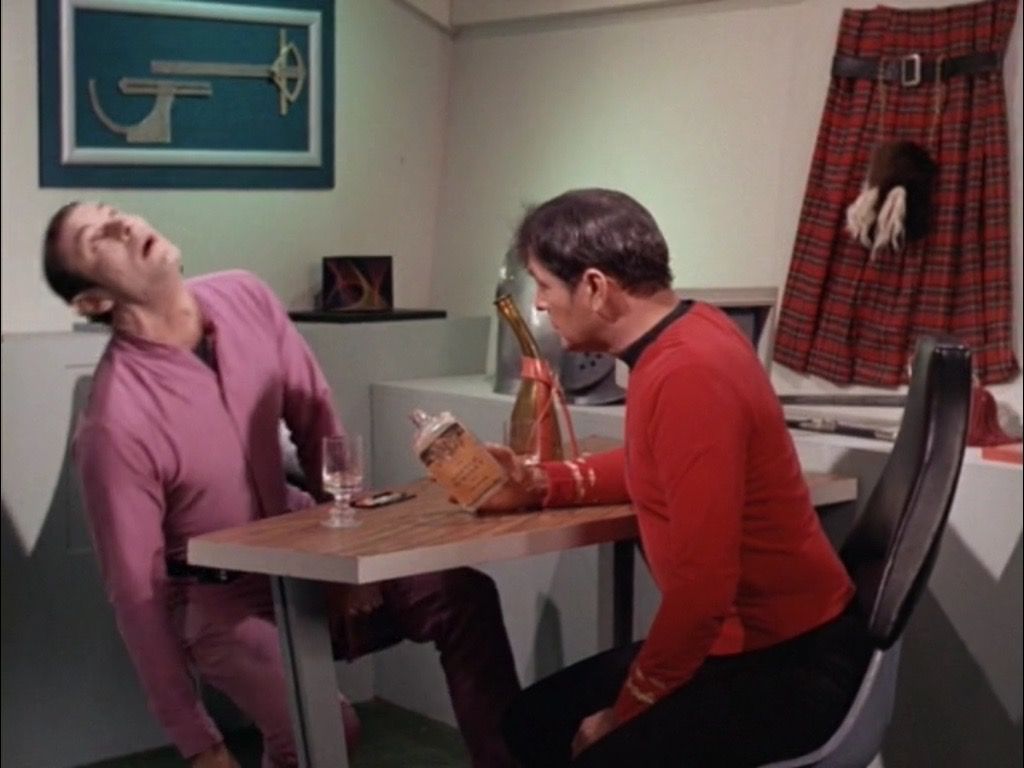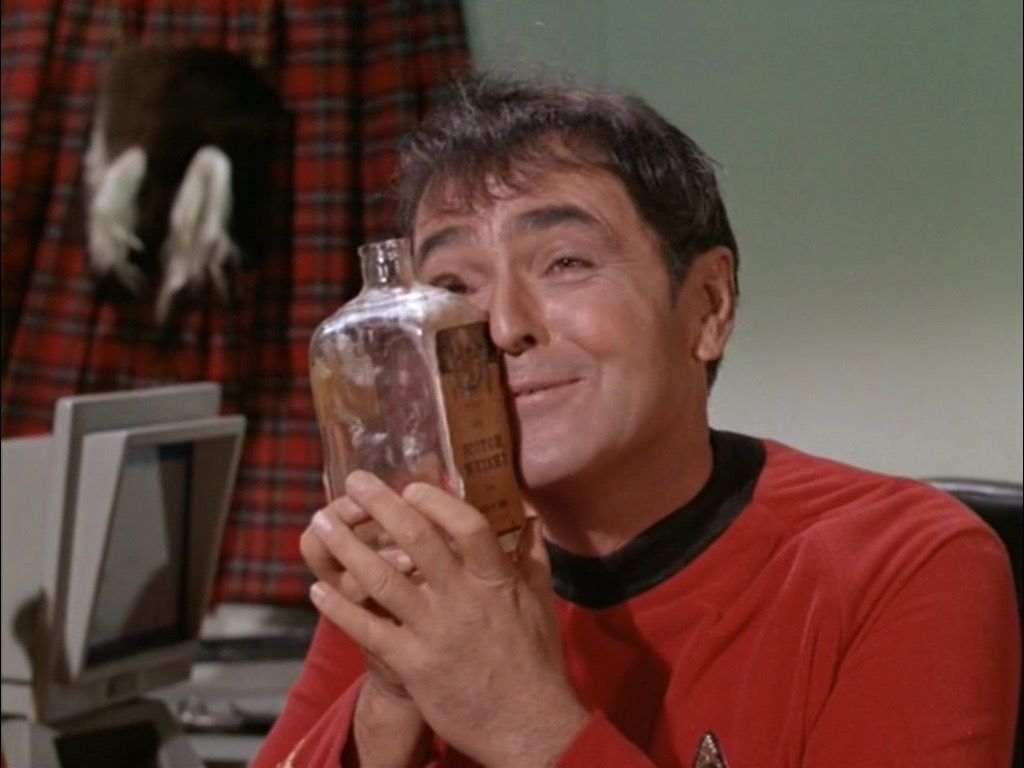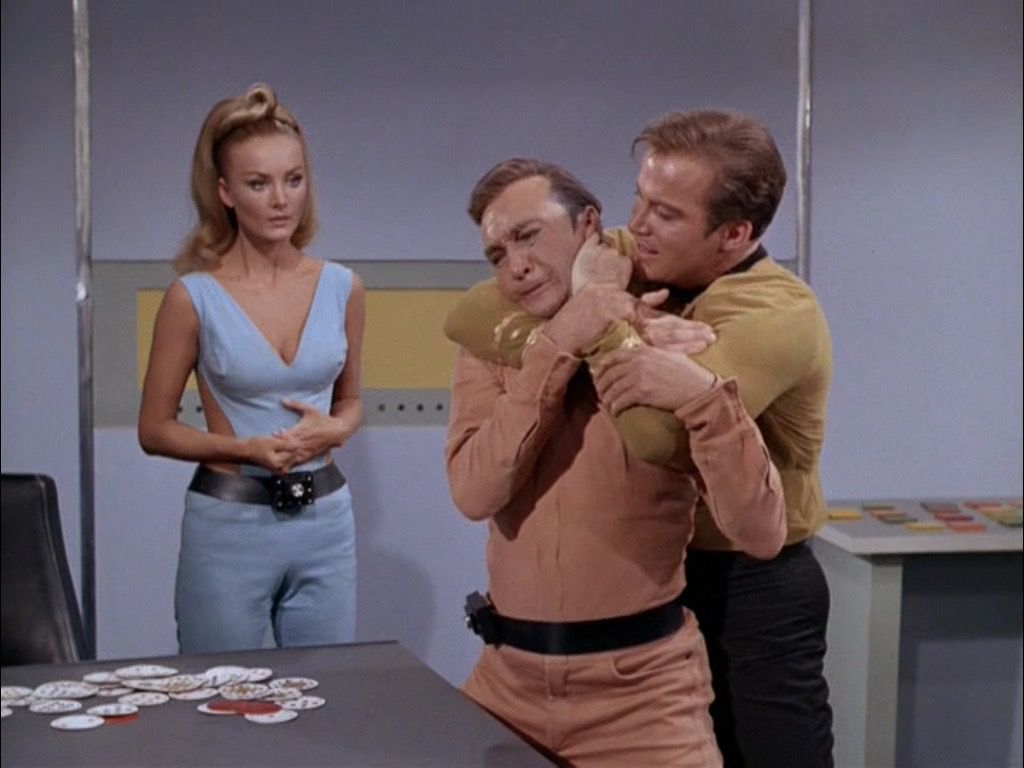2015 is nearly over, but before it is done there's time to squeeze in another episode of Star Trek. I somehow managed to accidentally skip watching Return to Tomorrow, so instead today I bring you
Nazis in Space!
If you loved the episode with the Romans or the one with the Gangsters, then you'll love the one with Nazis, right?
No, not so much.
I realize that they rationalize this as a case of cultural contamination, but I would prefer to have a fresh story idea over a look at an Earth culture on another planet again.
We begin with the Enterprise sailing past the planet Zeon (at left) on its way to Ekos. Gosh, those planets are really close together. Spock tells us that the "Ekosians are a primitive, warlike people in a state of anarchy. The other planet, Zeon, has a relatively high technology, and its people are peaceful."
They are headed toward Ekos to find Kirk's old history professor, John Gill (projected above between Spock and McCoy), who has gone missing. As they head toward Ekos, the ship is attacked by a nuclear missile, which was a big surprise because Ekos shouldn't be that technically advanced. Something is amiss.
Curiously, Kirk and Spock are injected with transponders--devices that will allow them to be located and beamed up, even if they have lost their communicators. If he hasn't heard from them, Scotty is to beam them up in 3 hours no matter what.
Kirk and Spock beam down only to discover that the Ekosians are Nazis and that John Gill is their Fuhrer! The Ekosians are hellbent on exterminating the Zeons. I guess Gill decided that the Federation's non-interference Directive is more of a guideline than a rule.
Kirk and Spock are caught by a Nazi who they overpower so that they can take his uniform. Wash, rinse and repeat. Soon they both have uniforms, which brings us to the whole point of the episode...
seeing Kirk and Spock (and later McCoy) as Nazis. The other purpose to the episode: re-using existing props, costumes & sets.)
They even get to change their Nazi uniforms a couple of times.
In between changes of clothes, they get captured, tortured and escape because Spock is awesome. Digging out their transponder crystals, Spock uses them to create a laser beam to cut their way through the lock on their cell door. Interestingly, later on when they are able to get into communication with the ship, there was no discussion of them being overdue, finding the transponders without Kirk & Spock, the crew being worried...nothing at all.
After escaping they meet up with the underground Zeons who have names like Davod, Isak and Abrom. It's almost as if the script writers are trying to draw a parallel or something to our world. Yeah, we get it.
It would be okay if there was a big moral payoff at the end here, but I don't think that Patterns of Force ever really delivers that. They end by reminding us that absolute power corrupts absolutely, but I think that there could have been so much more done here.
They spend more time making fun of Spock instead. Oh, well.
Just as the Ekosians are launching an invasion force toward Zeon, our heroes finally find John Gill, but he's drugged and totally out of it. Over McCoy's complaints, Kirk has McCoy inject Gill with stimulants, but they have no effect, so he calls in Spock to reach directly into his mind.
Spock is perhaps less than helpful: "I have created a condition in which Gill cannot initiate speech or any other action, but he can reply to questions." Really? So they play 20 Questions with Gill until Kirk gets frustrated and shoots him up again and then slaps him around. Really.
In the end it worked. Gill was able to recall the invasion fleet and reveal the traitor. Apparently Gill had just been trying to help the Ekosians, but he finally realized the error of his ways saying "Even historians fail to learn from history. They repeat the same mistakes. Let the killing end." Earlier Kirk had called Gill "the kindest, gentlest man I ever knew." It is beyond belief that such a man, a brilliant historian no less, would step in and use Nazi Germany as the model to help a culture.
In the end all the bad Nazis die, the good ones lead the way forward to peace with the Zeons and we get our message about absolute power. Hurrah.
Composer George Duning gave us six and a half minutes of new music for this episode, a theme called Military Mite that is used several times for the Nazis. It works just fine in the episode, but isn't too exciting to listen to outside of the episode itself.
I mistakenly skipped Return to Tomorrow, so that will be the next Star Trek episode to appear here, likely early in the new year.
Nazis in Space!
If you loved the episode with the Romans or the one with the Gangsters, then you'll love the one with Nazis, right?
No, not so much.
I realize that they rationalize this as a case of cultural contamination, but I would prefer to have a fresh story idea over a look at an Earth culture on another planet again.
We begin with the Enterprise sailing past the planet Zeon (at left) on its way to Ekos. Gosh, those planets are really close together. Spock tells us that the "Ekosians are a primitive, warlike people in a state of anarchy. The other planet, Zeon, has a relatively high technology, and its people are peaceful."
They are headed toward Ekos to find Kirk's old history professor, John Gill (projected above between Spock and McCoy), who has gone missing. As they head toward Ekos, the ship is attacked by a nuclear missile, which was a big surprise because Ekos shouldn't be that technically advanced. Something is amiss.
Curiously, Kirk and Spock are injected with transponders--devices that will allow them to be located and beamed up, even if they have lost their communicators. If he hasn't heard from them, Scotty is to beam them up in 3 hours no matter what.
Kirk and Spock beam down only to discover that the Ekosians are Nazis and that John Gill is their Fuhrer! The Ekosians are hellbent on exterminating the Zeons. I guess Gill decided that the Federation's non-interference Directive is more of a guideline than a rule.
Kirk and Spock are caught by a Nazi who they overpower so that they can take his uniform. Wash, rinse and repeat. Soon they both have uniforms, which brings us to the whole point of the episode...
seeing Kirk and Spock (and later McCoy) as Nazis. The other purpose to the episode: re-using existing props, costumes & sets.)
They even get to change their Nazi uniforms a couple of times.
In between changes of clothes, they get captured, tortured and escape because Spock is awesome. Digging out their transponder crystals, Spock uses them to create a laser beam to cut their way through the lock on their cell door. Interestingly, later on when they are able to get into communication with the ship, there was no discussion of them being overdue, finding the transponders without Kirk & Spock, the crew being worried...nothing at all.
After escaping they meet up with the underground Zeons who have names like Davod, Isak and Abrom. It's almost as if the script writers are trying to draw a parallel or something to our world. Yeah, we get it.
It would be okay if there was a big moral payoff at the end here, but I don't think that Patterns of Force ever really delivers that. They end by reminding us that absolute power corrupts absolutely, but I think that there could have been so much more done here.
Just as the Ekosians are launching an invasion force toward Zeon, our heroes finally find John Gill, but he's drugged and totally out of it. Over McCoy's complaints, Kirk has McCoy inject Gill with stimulants, but they have no effect, so he calls in Spock to reach directly into his mind.
Spock is perhaps less than helpful: "I have created a condition in which Gill cannot initiate speech or any other action, but he can reply to questions." Really? So they play 20 Questions with Gill until Kirk gets frustrated and shoots him up again and then slaps him around. Really.
In the end it worked. Gill was able to recall the invasion fleet and reveal the traitor. Apparently Gill had just been trying to help the Ekosians, but he finally realized the error of his ways saying "Even historians fail to learn from history. They repeat the same mistakes. Let the killing end." Earlier Kirk had called Gill "the kindest, gentlest man I ever knew." It is beyond belief that such a man, a brilliant historian no less, would step in and use Nazi Germany as the model to help a culture.
In the end all the bad Nazis die, the good ones lead the way forward to peace with the Zeons and we get our message about absolute power. Hurrah.
Composer George Duning gave us six and a half minutes of new music for this episode, a theme called Military Mite that is used several times for the Nazis. It works just fine in the episode, but isn't too exciting to listen to outside of the episode itself.
I mistakenly skipped Return to Tomorrow, so that will be the next Star Trek episode to appear here, likely early in the new year.
